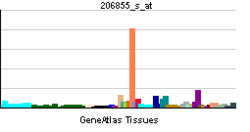HYAL2
| View/Edit Human | View/Edit Mouse |
Hyaluronidase-2 is an enzyme that in humans is encoded by the HYAL2 gene.[3][4][5]
This gene encodes a protein which is similar in structure to hyaluronidases. Hyaluronidases intracellularly degrade hyaluronan, one of the major glycosaminoglycans of the extracellular matrix. Hyaluronan is thought to be involved in cell proliferation, migration and differentiation. Varying functions have been described for this protein. It has been described as a lysosomal hyaluronidase which is active at a pH below 4 and specifically hydrolyzes high molecular weight hyaluronan. It has also been described as a GPI-anchored cell surface protein which does not display hyaluronidase activity but does serve as a receptor for the oncogenic virus Jaagsiekte sheep retrovirus. The gene is one of several related genes in a region of chromosome 3p21.3 associated with tumor suppression. This gene encodes two alternatively spliced transcript variants which differ only in the 5' UTR.[5]
References
- ↑ "Human PubMed Reference:".
- ↑ "Mouse PubMed Reference:".
- ↑ Lepperdinger G, Strobl B, Kreil G (Sep 1998). "HYAL2, a human gene expressed in many cells, encodes a lysosomal hyaluronidase with a novel type of specificity". J Biol Chem. 273 (35): 22466–70. doi:10.1074/jbc.273.35.22466. PMID 9712871.
- ↑ Strobl B, Wechselberger C, Beier DR, Lepperdinger G (Dec 1998). "Structural organization and chromosomal localization of Hyal2, a gene encoding a lysosomal hyaluronidase". Genomics. 53 (2): 214–9. doi:10.1006/geno.1998.5472. PMID 9790770.
- 1 2 "Entrez Gene: HYAL2 hyaluronoglucosaminidase 2".
Further reading
- Lepperdinger G, Müllegger J, Kreil G (2002). "Hyal2--less active, but more versatile?". Matrix Biol. 20 (8): 509–14. doi:10.1016/S0945-053X(01)00170-6. PMID 11731268.
- Maruyama K, Sugano S (1994). "Oligo-capping: a simple method to replace the cap structure of eukaryotic mRNAs with oligoribonucleotides". Gene. 138 (1–2): 171–4. doi:10.1016/0378-1119(94)90802-8. PMID 8125298.
- Wei MH, Latif F, Bader S, et al. (1996). "Construction of a 600-kilobase cosmid clone contig and generation of a transcriptional map surrounding the lung cancer tumor suppressor gene (TSG) locus on human chromosome 3p21.3: progress toward the isolation of a lung cancer TSG". Cancer Res. 56 (7): 1487–92. PMID 8603390.
- Andersson B, Wentland MA, Ricafrente JY, et al. (1996). "A "double adaptor" method for improved shotgun library construction". Anal. Biochem. 236 (1): 107–13. doi:10.1006/abio.1996.0138. PMID 8619474.
- Yu W, Andersson B, Worley KC, et al. (1997). "Large-scale concatenation cDNA sequencing". Genome Res. 7 (4): 353–8. doi:10.1101/gr.7.4.353. PMC 139146
 . PMID 9110174.
. PMID 9110174. - Suzuki Y, Yoshitomo-Nakagawa K, Maruyama K, et al. (1997). "Construction and characterization of a full length-enriched and a 5'-end-enriched cDNA library". Gene. 200 (1–2): 149–56. doi:10.1016/S0378-1119(97)00411-3. PMID 9373149.
- Sun L, Feusi E, Sibalic A, et al. (1999). "Expression profile of hyaluronidase mRNA transcripts in the kidney and in renal cells". Kidney Blood Press. Res. 21 (6): 413–8. doi:10.1159/000025893. PMID 9933825.
- Fiszer-Szafarz B, Litynska A, Zou L (2000). "Human hyaluronidases: electrophoretic multiple forms in somatic tissues and body fluids. Evidence for conserved hyaluronidase potential N-glycosylation sites in different mammalian species". J. Biochem. Biophys. Methods. 45 (2): 103–16. doi:10.1016/S0165-022X(00)00067-1. PMID 10989127.
- Lerman MI, Minna JD (2000). "The 630-kb lung cancer homozygous deletion region on human chromosome 3p21.3: identification and evaluation of the resident candidate tumor suppressor genes. The International Lung Cancer Chromosome 3p21.3 Tumor Suppressor Gene Consortium". Cancer Res. 60 (21): 6116–33. PMID 11085536.
- Rai SK, Duh FM, Vigdorovich V, et al. (2001). "Candidate tumor suppressor HYAL2 is a glycosylphosphatidylinositol (GPI)-anchored cell-surface receptor for jaagsiekte sheep retrovirus, the envelope protein of which mediates oncogenic transformation". Proc. Natl. Acad. Sci. U.S.A. 98 (8): 4443–8. doi:10.1073/pnas.071572898. PMC 31854
 . PMID 11296287.
. PMID 11296287. - Delpech B, Laquerriere A, Maingonnat C, et al. (2002). "Hyaluronidase is more elevated in human brain metastases than in primary brain tumours". Anticancer Res. 22 (4): 2423–7. PMID 12174938.
- Strausberg RL, Feingold EA, Grouse LH, et al. (2003). "Generation and initial analysis of more than 15,000 full-length human and mouse cDNA sequences". Proc. Natl. Acad. Sci. U.S.A. 99 (26): 16899–903. doi:10.1073/pnas.242603899. PMC 139241
 . PMID 12477932.
. PMID 12477932. - Liu SL, Duh FM, Lerman MI, Miller AD (2003). "Role of virus receptor Hyal2 in oncogenic transformation of rodent fibroblasts by sheep betaretrovirus env proteins". J. Virol. 77 (5): 2850–8. doi:10.1128/JVI.77.5.2850-2858.2003. PMC 149765
 . PMID 12584308.
. PMID 12584308. - Danilkovitch-Miagkova A, Duh FM, Kuzmin I, et al. (2003). "Hyaluronidase 2 negatively regulates RON receptor tyrosine kinase and mediates transformation of epithelial cells by jaagsiekte sheep retrovirus". Proc. Natl. Acad. Sci. U.S.A. 100 (8): 4580–5. doi:10.1073/pnas.0837136100. PMC 153598
 . PMID 12676986.
. PMID 12676986. - Junker N, Latini S, Petersen LN, Kristjansen PE (2003). "Expression and regulation patterns of hyaluronidases in small cell lung cancer and glioma lines". Oncol. Rep. 10 (3): 609–16. doi:10.3892/or.10.3.609. PMID 12684632.
- Ota T, Suzuki Y, Nishikawa T, et al. (2004). "Complete sequencing and characterization of 21,243 full-length human cDNAs". Nat. Genet. 36 (1): 40–5. doi:10.1038/ng1285. PMID 14702039.
- Gerhard DS, Wagner L, Feingold EA, et al. (2004). "The status, quality, and expansion of the NIH full-length cDNA project: the Mammalian Gene Collection (MGC)". Genome Res. 14 (10B): 2121–7. doi:10.1101/gr.2596504. PMC 528928
 . PMID 15489334.
. PMID 15489334.
